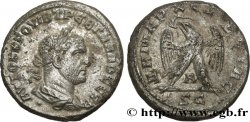正面
正面的说明书 Buste lauré, drapé et cuirassé de Trébonien Galle à droite, vu de trois quarts en arrière (A*2).
正面铭文 AUTOK K G OUIB TREB GALLOS SEB (Autokrator Kaisar Gaios Ouibios Trebonianos Gallos Sebastos)
正面的翻译 (L’empereur césar Caius Vibius Trebonien Galle auguste).
背面
背面的文字 //SC.
背面的说明书 Temple tétrastyle avec coupole semi-circulaire ; au milieu, statue de la Tyché d’Antioche assise de face sur un rocher avec l’Oronte nageant à ses pieds ; au-dessus, un bélier bondissant à droite, tournant la tête à gauche.
背面铭文 ANTIOCEWN - MHTRO KOLON/ D|E// (Antiocewn Mhtropolhwn Kolonias)
背面的翻译 (d’Antioche ville colonie).
历史细节
TREBONIANUS GALLUS
(06/251-06/253)
Trebonian Galle, originally from Perugia, was governor of Moesia during the reign of Trajan Decius. During the battle of Abritus, he refrains from helping Decius in difficulty: the Emperor is killed by the Goths. Trebonian is proclaimed august and signs peace with Kniva. He hastens to return to Rome where he associates on the one hand Hostilian, the last surviving son of Trajan Decius, as august, and on the other hand his own son Volusien, as caesar. When Hostilian dies of the plague or is murdered, Volusian becomes august. Trebonian Galle pays tribute to the Goths as the Sassanids of Sapor I threaten Syria and the plague continues to ravage the Empire. He takes up the persecutions against Christians, but has no policy. The invasion having resumed on the Danubian limes with the arrival of new barbarian hordes, Emilian is proclaimed august by his troops and marches on Italy. Trébonien Galle calls on Valérien to rescue him and the decisive encounter takes place in Terni in 253. Trébonien Galle and Volusien are beaten and find death in the battle of which Émilien emerges victorious for a short time, before being assassinated by his troops who joined Valérien Ier.










 对产品描述纠错
对产品描述纠错 打印
打印 分享我的选择
分享我的选择 提问
提问 Consign / sell
Consign / sell
 产品介绍
产品介绍










